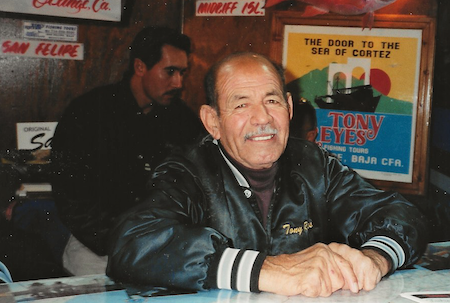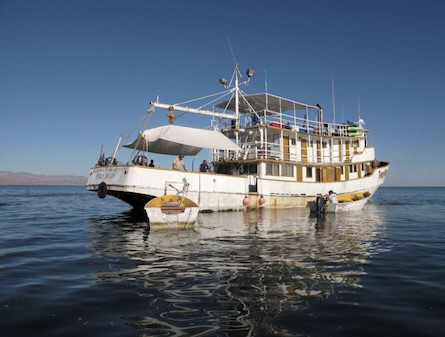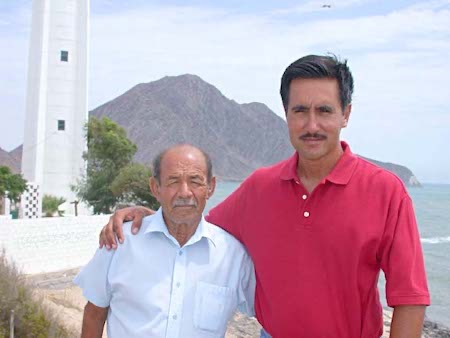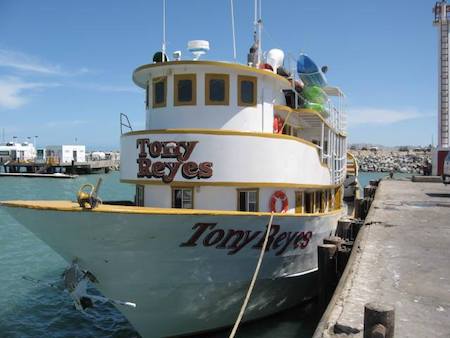 |  |
By Greg Niemann

Yellowtail were all over the channel between Punta La Gringa and Smith Island. It was hot stand-up fishing action, the feisty yellowtail chasing the largest concentration of boiling baitfish I’d ever seen. Don and I each picked up several nice “yellows” trolling Rapalas.
Then the fish went deep and we had to work to get them. By the time we’d arrived at the rocks north of the island, several pangas (fishing skiffs) were already there working a deep hole. There were three fishermen and a skipper in each of the small boats. It was obvious they knew what they were doing.
It was back in 1999 and Don and I had hired a local guy out of nearby Bahia de los Angeles. He did fine while trolling but was a bit slow when it came to maneuvering the panga for the deeper action.
The other pangas were landing beautiful yellows right and left, with their sunburned occupants doing a lot of whooping and hand slapping. That’s when I noticed most of them were in sister pangas, and all dispatched off that same larger vessel we’d seen anchored at Punta la Gringa.
The vessel was the 86-foot “Jose Andres,” a “mothership” that would leave San Felipe (some 250 miles to the north) each week with 18 fishermen, a crew of 12, and a half dozen pangas on board. Three anglers and a guide are assigned to each panga.
Fishing the Midriff
The mothership concept was started back in the early 1950s when San Felipe tourism was in its infancy. Midriff sportfishing legend Tony Reyes, who owned the “Jose Andres,” had been involved from the beginning.
Born in Mexico City in 1923, Tony went to the U.S. as a farm laborer at age 19. He followed the crops, working in Minnesota, North Dakota and Wyoming. In San Jose, California he was apprehended by the Immigration Department with an expired permit and deported to Tijuana, Mexico. “I really felt alone there,” he said. “I had no relations, no friends, no money, nothing. At first I slept in a pool hall, then a small hotel gave me a room and meals for working there, but no money.”
Then something happened that would change Reyes’ life. A San Diego tuna boat fisherman rented a room at the hotel in 1950. He advised Reyes to go to San Felipe to try to get a job on one of the commercial shrimp boats there. “Looking back, I’m glad they caught me and sent me to Baja California because otherwise I might have been picking fruit all my life,” he told me.

So Reyes went to San Felipe and worked as a shrimp boat deckhand to learn the business. He heard that Ensenada sportfishing boats also needed good crew members for their summer seasons. So, in Ensenada, Reyes became an apprentice guide aboard the 30 foot “Gaviota #1” where Captain Eddie Celaya helped him hone his skills.
He and Celaya met many American sportsmen and Reyes learned diplomacy and better English along with fishing. He showed me many photos from the Ensenada summers of the early 1950s. In one, he’s posing with a huge white sea bass with outdoors writer Lupe Saldana of the Los Angeles Times.
At the end of that first summer he returned to San Felipe with a second-hand panga. With no engine, he began rowing guests out to the local points where they caught corvina, cabrilla and the large totuava.
An American named Ralph suggested he have a motor, and advanced him his first $50.00 outboard motor. “Ralph just liked to go fishing and every time I took him we deducted from the $50.00 until it was all paid off,” recalled a grinning Tony Reyes. Shortly thereafter he began acquiring other pangas and motors and hiring other guides.
When the paved road brought the anticipated fishermen in 1951, Tony Reyes was ready. He knew how to fish; he had the boats and he had developed the contacts.
He had access to 50-foot shrimp boats and began taking anglers out for extended trips, expanding the trips to two and three days. The local fishing was great, but more species could be found in the waters to the south.
The Sea of Cortez narrows in an area called the “midriff,” a term popularized by the fishing/writing legend Ray Cannon. It is an area about 250 miles south of San Felipe where rich nutrients in deep channels are forced to the surface in upwelling caused by the rushing tides. Fishing in the midriff is legendary but in the 1950s there were no roads to the area.
Pangas aboard a mothership
Even today, the small village of Bahia de los Angeles is a 400-mile drive from Tijuana. So several San Felipe fishermen, including Charlie Rucker and Tony Reyes, developed the “pangas aboard a mothership” concept. Reyes told me that Rucker was actually the first one to do it and that he had copied him. Regardless, Rucker didn’t stay involved long and it was the Tony Reyes fleet that has endured.
The Tony Reyes trips expanded to five-and six-day jaunts into the midriff. Fishermen traveled, ate, and slept aboard the mothership and they launched the pangas to fish. Early on, he rented the boats before purchasing his own.
The “Jose Andres” had been the flagship since 1987 and featured three heads, two showers, a full galley, and inside staterooms, although most anglers preferred to sleep in the open-air bunks. It featured bait tanks, a walk-in refrigerator, walk-in freezer, and other amenities dedicated to a week’s fishing (Sunday-Friday, each week).

Americans long played a hand in the Tony Reyes success story. David Fink of Davey’s Locker in Newport Beach suggested that he rent out those shrimp boats for the extended trips. Davey’s Locker then helped supply anglers. For a while Tom Payne of Redondo Beach supplied the booking. For many years, now, it’s been Longfin Fishing Suppliers in Orange who book the Tony Reyes trips.
While Tony Reyes still coordinated the trips for decades, he turned the captain’s chair over to his son, Tony Reyes Jr. in 1990. When I visited him in 2000, Tony Sr. modestly told me that his sons were better captains. His other son Heriberto was also a skipper for a different charter company.
Back then other ships fishing the midriff long-range included the 87-foot “Celia Angelina,” the 105-foot steel hull “Erik” (Baja Sportsfishing), the 90-foot “Poseidon,” and the Captain Villegas charter trips.
I sat in the tiled dining room of Tony Reyes’ trim home in San Felipe and listened to him reminisce about fishing, San Felipe, and his life. He showed photos of his career on the sea. Several of his local friends came by, for favors, for advice, and the spry Tony Reyes seemingly had time for everyone. He did not look, nor act 77 years old.
I learned how he developed a small resort south of San Felipe called Okie’s Landing, and later sold it. I learned that in 1967 he joined other world-class fishermen for a kingfish adventure in New Zealand. “They call them kingfish, but they’re really yellowtail – but much bigger than anything we get. We caught some up to 120 pounds,” he recalled.
Tony Reyes has caught totuava up to 300 pounds and currently advocates their protection. He’s caught a 500-pound black sea bass, his largest fish, he said.
The old photos showed bigger fish and a younger Tony Reyes and a sleepy San Felipe that is no more. One photo shows a small wooden Tony Reyes fishing shack on a dirt road “downtown” San Felipe at the stoplight. The photo he saved for last was of him and his mother, with their heads both facing the same way. Obviously, it was his favorite. “Tom Miller took this photo,” he told me, referring to a long-time Baja buff and the author of several Baja-related books.

Those were nostalgic times for Tony Reyes. He said his sons are better fishermen than he ever was. “Smarter, always looking,” he explained. Tony Reyes didn’t fear the Immigration anymore when he went north to work the trade shows. He was well known and well liked. “You know, people keep coming back. I think this year we’ll get the fourth generation of one family,” Reyes beamed. A restaurant owner from Long Beach has already got his son, and grandson on the Tony Reyes trips. This year the great-grandson should be ready.
The “pangas aboard a mothership” concept is popular, effective, and practical for long range Sea of Cortez fishing adventures. When many sportsmen think of fishing the midriff region of the Sea of Cortez, they think of Tony Reyes.
Tony Reyes Sr. passed away on December 18, 2009. His legacy lives on as in 2004 he and his son purchased the larger and faster Captain Villegas ship, which was rechristened the “Tony Reyes” to continue long-range trips to the “midriff.” Bookings are still through Longfin Tackle Store in Orange, CA.
Info: info(at)thelongfin.com
About Greg
Greg Niemann, a long-time Baja writer, is the author of Baja Fever, Baja Legends, Palm Springs Legends, Las Vegas Legends, and Big Brown: The Untold Story of UPS. Visit www.gregniemann.com.

Very excellent service, needed insurance for Mexico, price was fair. The custumer service rep was...

Good seevice have use baja bound for many years good price....

Quick, easy and gr8 pricing .